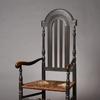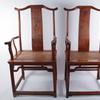THE HOBART ‘QUAIL’ BOWLS AT BONHAMS SALE OF CHINESE CERAMICS AND WORKS OF ART
- NEW YORK, New York
- /
- February 27, 2019
AN EXCEPTIONALLY RARE PAIR OF IMPERIAL 'QUAIL AND CHRYSANTHEMUM’ BOWLS, YONGZHENG MARKS AND OF THE PERIOD
Auction Date: March 18, 2019
New York- The highlight of Bonhams Chinese Works of Art sale is an exceedingly rare and important Imperial pair of bowls exquisitely enameled with the rare design of quail and chrysanthemum blossoms, bearing Yongzheng six-character underglaze-blue marks and of the period (1723-1735). These masterpieces of Yongzheng Imperial porcelain, will be offered on Monday, March 18 at an estimate of $300,000–500,000.
The important pair of 'quail' bowls, from the collection of Virginia "Ella" Hobart (1876-1958), and thence by descent, was acquired by Virginia Hobart in the early 20th century, possibly from Yamanaka. Virginia Hobart became an heiress in 1892 when, with her two siblings, she inherited her father's fortune from timber, gold and silver mining. In 1913-1914 Virginia and her husband Charles Baldwin travelled to China and Japan, returning in time to attend the Pan-Pacific exhibition in San Francisco in 1915. In her letter to her son, dated January 29, 1913, she writes with great enthusiasm of meeting the famed dealer Sadajiro Yamanaka in Kyoto the day before. Following Charles's death in 1936, Virginia sold Claremont Mansion in Colorado Springs, Colorado, which was built after the style of Versailles, and relocated to San Francisco.
The exceptionally rare pair of bowls epitomize the very finest Imperial porcelain of the Yongzheng reign renowned for its innovative design, unsurpassed elegance and exquisite artistry. They are particularly rare in two aspects: firstly, in the design incorporating chrysanthemums rather than prunus and nandina, therefore symbolizing Autumn; and in the continuous decoration over the rim and onto the interior, in a technique known as guoqiangzhi rather than retaining a plain undecorated interior.
The palette of the superbly painted and enameled bowls can be described as a combination of falangcai and fencai; the former, translating as ‘foreign colors’, and the latter corresponding to the ‘famille rose’ palette. The falangcai enamels are apparent on the present lot in the brown and ochre enameling of the quail. Related falangcai ‘quail’ decorated bowl and a teapot and cover, Yongzheng four-character blue-enameled marks and period, are in the National Palace Museum, Taipei.
The falangcai palette and manner of painting was influenced by the Jesuit painters in the Court, such as Giuseppe Castiglione (1688-1766), known as Lang Shining, as can be seen in the treatment and coloring of the feathers of a sparrow in the painting titled ‘Chrysanthemums’ in the album Immortal Blossoms in an Everlasting Spring, which is considered to be a masterpiece dating to the Yongzheng reign, in the National Palace Museum, Taipei.
Several closely related quail enameled bowls of the Yongzheng period can be found in important museum and private collections: These include a bowl in the Art Institute of Chicago, Hongzhi mark and period, which was later enameled in the Imperial ateliers during the Yongzheng reign; this bowl is remarkably similar to the Hobart bowls in the pearl-ground manner of enameling of the quail as well as the continuous design over the rim and onto the interior of the bowl and in the symbolic meaning of the design. A further Yongzheng mark and period bowl is in the Foundation Baur, Geneva, and another similar bowl was formerly in the Meiyintang Collection. However, these two latter examples are decorated with prunus and nandina, representing the season of Winter, whereas the Hobart bowls represent Autumn; importantly, whilst the two latter related examples are undecorated to the interior, the Hobart bowls are superbly decorated in the guoqiangzhi manner, with the chrysanthemum design continuing over the rim and onto the interior as is the Art Institute of Chicago example. The use of undecorated white glazed Ming dynasty porcelain by the Imperial Workshops during the Qing dynasty is known and a related example is in the National Palace Museum Taipei. It is therefore likely that the Hobart bowls present the progression in design between the Chicago and Baur Foundation examples.
Much admired in China for their courage and fighting spirit, pairs of quail, shuang an, are a homophone for 'peace and prosperity'. Chrysanthemums ju, are among the earliest cultivated flowers in China. Blooming in the colder months, they symbolize fortitude as well as longevity and are also associated with the Autumn season. Combined with pairs of quail, chrysanthemums convey the doubly-propitious wish of 'May you live in peace'. The fallen leaf on the pearl-ground is known as luo ye which in Chinese is a pun for le ye meaning ‘work in contentment’. The decorative combination therefore forms the phrase An ju le ye which may be interpreted as meaning ‘May you live in peace and work in contentment’. This pun is shared by both the present Hobart bowls and the Chicago bowl, as one of the quail in the Chicago bowl is enamelled holding a leaf in its beak, further reinforcing the proximity in date of production. The auspicious imagery is further augmented by the guoqiangzhi technique of continuing the design into the interior, as when spoken the phrase guoqiangzhi sounds like “maintaining peaceful government”, a compliment to the emperor’s benevolent rule.
Furthermore, drawing its inspiration from earlier periods, quail and chrysanthemums were a popular theme within the much celebrated 'bird-and-flower' painting genre of the Song dynasty. This genre was revived by the Yongzheng Emperor and represented on Imperial porcelain under the direction of Tang Ying (1682-1756), the celebrated superintendent of the Imperial kilns at Jingdezhen.
The elegant rendering of blossoming chrysanthemums, depicted in various stages of bloom on the present bowls, were very likely inspired by the celebrated paintings of Yun Shouping (1633-1690) and his unique manner of combining bold colors and washes to emphasize the distinct beauty of flowers.
These remarkable bowls can be numbered amongst the finest Imperial porcelain produced at the zenith of porcelain production during the reign of the Yongzheng Emperor, known for his personal involvement in arts for the Imperial Court, his refined aesthetic taste and high standards.
Contact:
Sung-Hee KimBonhams
sunghee.kim@bonhams.com



10270x400_c.jpg)












_-Closing-the-Distance_100x100_c.jpg)








